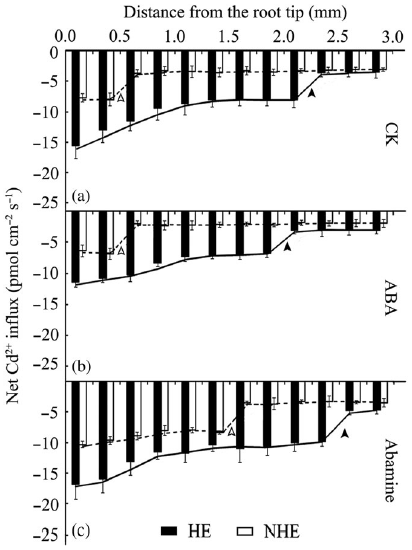NMT是基因功能的活体检测技术,已被103位诺贝尔奖得主所在单位,及北大、清华、中科院使用。
期刊:Plant cell and environmen
主题:ABA可抑制超富集东南景天对Cd的吸收
标题:Abscisic acid‐mediated modifications of radial apoplastic transport pathway play a key role in cadmium uptake in hyperaccumulator Sedum alfredii
影响因子:5.415
检测指标:Cd2+流速
检测样品:东南景天根部距离根尖0mm至3mm,间隔0.25mm
Cd2+流速流实验处理方法:
9周龄的东南景天幼苗,分别用25 μM Cd(NO3)2、25 μM Cd(NO3)2+1 μM ABA、25 μM Cd(NO3)2+50 μM Abamine处理7天
Cd2+流速流实验测试液成份:文献无
推荐测试液:0.025mM CdCl2,0.1mM KCl,pH6.0
作者:浙江大学李廷强、陶琦
文章简介
ABA是植物抵抗重金属毒害的一种重要的植物激素。但是,ABA如何影响植物根的质体外运输途径以及重金属离子的吸收,这些过程机理还不明确。
2019年初,浙江大学李廷强教授团队在Plant, Cell & Environment上发表了脱落酸(ABA)抑制东南景天富集重金属镉(Cd)的研究成果,文章标题为“Abscisic acid‐mediated modifications of radial apoplastic transport pathway play a key role in cadmium uptake in hyperaccumulator Sedum alfredii”。李教授课题组通过比较两种东南景天在Cd处理下不同的生理变化及基因表达情况,发现在非超富集型(NHE)东南景天中,由于ABA合成基因(SaABA2,SaNCED)表达上调,根的内源性ABA含量升高,而超富集型(HE)东南景天中不存在这种变化。而且,NHE东南景天中内胚层凯氏带(CSs)和栓质层(SL)的沉积更靠近根尖。以上结果表明:ABA促进了苯丙氨酸解氨酶、过氧化物酶和栓质相关基因(SaCYP86A1, SaGPAT5, and SaKCS20)的表达,从而调控两种质体外屏障的沉积过程。
本研究利用基于非损伤微测技术的NMT活体生理检测仪Physiolyzer®,检测植物根部的Cd吸收速率,发现两种类型东南景天中,Cd的吸收随着距离根尖越远而逐渐减少;HE东南景天根尖区的Cd吸收总含量更高。不同条件处理下,Cd吸收的下降位点(图中黑色箭头表示)与根尖距离不同,且下降位点与CSs的起始位点一致。实验结果表明:ABA通过促进CSs和SL的沉积形成屏障,从而显著抑制Cd进入根内。

不同条件处理下,两种类型东南景天根部Cd2+吸收速率对比,负值表示吸收。
英文摘要
Abscisic acid (ABA) is a key phytohormone underlying plant resistance to toxic metals. However, regulatory effects of ABA on apoplastic transport in roots and consequences for uptake of metal ions are poorly understood.
Here, we demonstrate how ABA regulates development of apoplastic barriers in roots of two ecotypes of Sedum alfredii and assess effects on cadmium (Cd) uptake. Under Cd treatment, increased endogenous ABA level was detected in roots of nonhyperaccumulating ecotype (NHE) due to up‐regulated expressions of ABA biosynthesis genes (SaABA2, SaNCED), but no change was observed in hyperaccumulating ecotype (HE). Simultaneously, endodermal Casparian strips (CSs) and suberin lamellae (SL) were deposited closer to root tips of NHE compared with HE. Interestingly, the vessel‐to‐CSs overlap was identified as an ABA‐driven anatomical trait.
Results of correlation analyses and exogenous applications of ABA/Abamine indicate that ABA regulates development of both types of apoplastic barriers through promoting activities of phenylalanine ammonialyase, peroxidase, and expressions of suberin‐related genes (SaCYP86A1, SaGPAT5, and SaKCS20). Using scanning ion‐selected electrode technique and PTS tracer confirmed that ABA‐promoted deposition of CSs and SL significantly reduced Cd entrance into root stele.
Therefore, maintenance of low ABA levels in HE minimized deposition of apoplastic barriers and allowed maximization of Cd uptake via apoplastic pathway.
中文摘要(谷歌机翻)
脱落酸(ABA)是植物抵抗有毒金属的基础的重要植物激素。然而,人们对ABA对根部质外体运输的调节作用以及对金属离子吸收的后果了解甚少。
在这里,我们演示了ABA如何调节两种生态型苜蓿景天的根中的质外性障碍的发展,并评估对镉(Cd)吸收的影响。在Cd处理下,由于ABA生物合成基因(SaABA2,SaNCED)的表达上调,在非高累积生态型(NHE)的根中检测到内源ABA水平升高,但在高累积生态型(HE)中未观察到变化。同时,与HE相比,内膜Casparian条(CSs)和suberin lamellae(SL)沉积在NHE根尖附近。有趣的是,血管与CS的重叠被确定为ABA驱动的解剖特征。
相关分析和ABA /阿巴胺的外源应用的结果表明,ABA通过促进苯丙氨酸解氨酶,过氧化物酶的活性以及与地下蛋白相关基因(SaCYP86A1,SaGPAT5和SaKCS20)的表达来调节两种质外性障碍的发展。使用扫描离子选择电极技术和PTS示踪剂证实,ABA促进了CS和SL的沉积,显着减少了Cd进入根石碑。
因此,维持HE中低ABA水平可最大程度地减少质外性障碍的沉积,并允许通过质外途径最大程度地吸收Cd。
文章链接:
